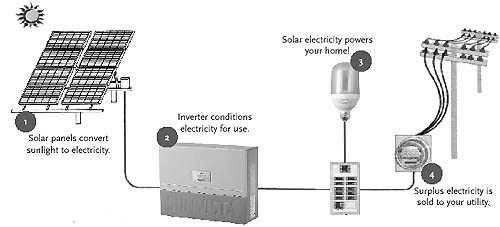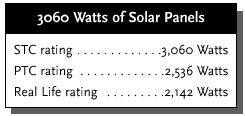Net Metering
California’s net metering laws mandate that your utility company purchase your excess power at standard retail prices. Every kilowatt- hour (kWh) of solar power reduces the electric bill by the same kWh. Most utilities have tier rated structures to encourage energy conservation. The more electricity one consumes, the higher the price one is charged. A well designed solar PV system will meet over 75% your household needs. Solar energy will remove the most expensive electricity from your energy bill first. The remaining electricity is purchased from the utility at their lowest or baseline rate. Currently, PG&E's highest rate is 35.2 cents while the baseline is 11.4 cents.

Some utilities have instituted “Time of Use” metering, to encourage homeowners to conserve in the afternoon. In the past, seasonal rates were offered with lower prices during the winter months. These rates allow you to “sell” your electricity back at higher rates. In the evening you can buy that same power back at lower rates. If you are already on a Time of Use (TOU) rate, you should stay on it. If the orientation or shading is a concern on the south roof, a west facing PV array combined with Time of Use metering is a good option.
How Much Power Can My Solar System Produce?
In reality, the home-solar industry is relatively new, so adequate standards of measurement haven't yet been developed or adopted to level the playing field for everyone. In the meantime, all we can do is be completely honest with you about the true output you can expect from an up-to-date solar systems.
STC or "Name Plate" Ratings: STC stands for Standard Test Conditions. It is the rated output in watts that the manufacturer puts on its photovoltaic (PV) modules under laboratory- perfect conditions. STC ratings are generally used by the solar industry, installers, our competitors, and the general public.
PTC Ratings: PTC stands for Practical Test Conditions or the ratings under the PVUSA Test Conditions. This is the standard used by the California Energy Commission (CEC), and in general runs about 17% - 20% less than STC.
Real-Life Expectations: Many industry professionals have studied the issue of photovoltaic ratings and are uncomfortable with both STC and PTC ratings as they seem overrated to real world conditions. At a comprehensive seminar at the national solar conference in Portland, Oregon, the consensus was that to be conservative in one's expectations -- one should expect their solar-energy system to yield in AC output to their electrical panel about 75% of STC (manufacturer’s name plate) ratings or multiply by 0.75. We use 5.2 sun hours in most estimates.
Summary: Throughout our literature, like all in the solar industry, we will use STC ratings, but we recommend that you be conservative in your expectations and calculate your numbers for “real life” expectations. What this means is well- summarized by the example at the right featuring a solar panel we commonly use for 3kW systems. This is how a 3kW system on the outset results in a 2kW reading on the inverter display.
Projected Savings On Your 3 KW Residential Solar-Energy System

The graph assumes electric utility rates will increase 5.5% annually for 30 years and that a solar system costs you the present amount of $0.14/ kWh. Note: TOU (time of use) metering may not be the best solar solution for all homes. Savings vary slightly from these numbers depending upon your utility company. These are averages for the State of California.